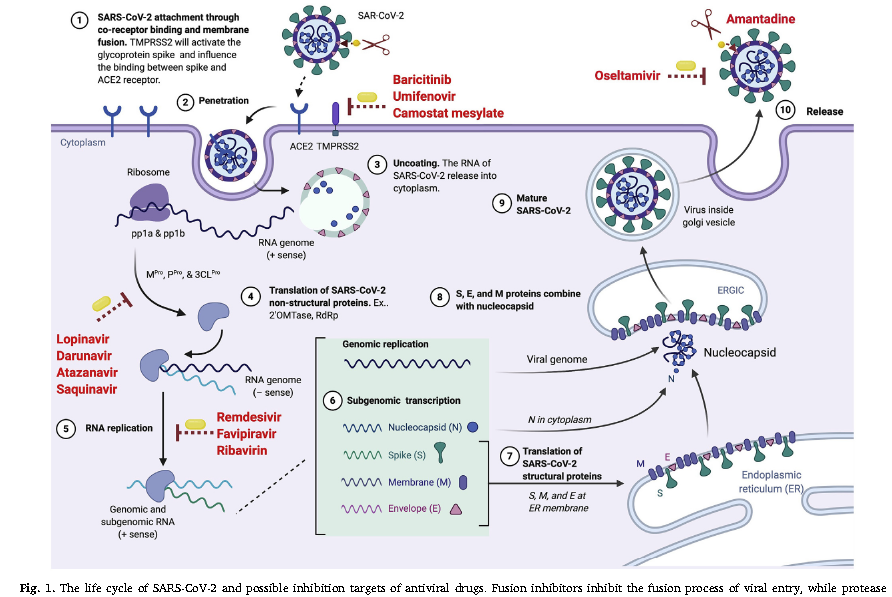博文
有希望的抑制剂可能导致治疗COVID-19的新抗病毒药物
||
有希望的抑制剂可能导致治疗COVID-19的新抗病毒药物
诸平
Graphical abstract

据加拿大阿尔伯塔大学(University of Alberta简称U of A)2021年8月10日提供的消息,该大学的研究人员指出,有希望的抑制剂,可能导致新的抗病毒药物治疗COVID-19(Researchers pinpoint promising inhibitors that could lead to new antiviral drugs to treat COVID-19),相关研究结果于2021年5月30日已经在《欧洲药物化学》(European Journal of Medicinal Chemistry)杂志网站发表——Wayne Vuong,Conrad Fischer,Muhammad Bashir Khan, Marco J. van Belkum,Tess Lamer, Kurtis D. Willoughby, Jimmy Lu, Elena Arutyunova, Michael A.Joyce, Holly A.Saffran, Justin A.Shields, Howard S.Young, James A.Nieman, D. Lorne Tyrrell, M. Joanne Lemieux, John C.Vederas. Improved SARS-CoV-2 Mpro inhibitors based on feline antiviral drug GC376: Structural enhancements, increased solubility, and micellar studies. European Journal of Medicinal Chemistry, Volume 222, 15 October 2021, 113584. DOI: 10.1016/j.ejmech.2021.113584. Available online 30 May 2021. https://doi.org/10.1016/j.ejmech.2021.113584
快速开发安全有效的COVID-19疫苗是帮助控制新冠疫情大流行的重要一步。但随着病毒变种的增加和全球疫苗分布的不均衡,COVID-19是一种必须在一段时间内加以管理的传染性疾病。针对病毒复制方式的抗病毒药物可能是治疗未接种和接种不足人群爆发COVID-19的最佳选择。
来自阿尔伯塔大学的研究人员利用萨斯喀彻温大学(University of Saskatchewan)的国家研究机构加拿大光源(Canadian Light Source简称CLS),分离出了有望用于治疗COVID-19感染的抑制剂。科学家们在CLS的COVID-19特别倡议期间远程使用了同步加速器。该倡议是为了支持帮助抗击新冠疫情大流行的研究而创建的。
U of A医学和牙医学院(U of A's Faculty of Medicine & Dentistry)教授乔安妮·勒米厄(Joanne Lemieux)说:“在CLS和U of A多个团队的帮助下,包括我们的实验室、生物化学系的Young实验室(Young lab in the Department of Biochemistry)、化学系的Vederas实验室(Vederas lab in the Department of Chemistry)和医学微生物与免疫学系的Tyrrell团队(Tyrrell team in the Department of Medical Microbiology and Immunology),我们在开发一组非常有前途的抑制剂方面一直非常有效合作。”
同步加速器(synchrotron)产生的光比太阳亮数百万倍,帮助研究人员找到关于样本的非常详细的信息。乔安妮·勒米厄及其同事们利用CLS的CMCF光束(CMCF beamline at the CLS)寻找可以阻止SARS-CoV-2(导致COVID-19的病毒)在人类细胞内复制的分子。
此研究小组发现了一组以蛋白酶(protease)为靶点的抑制剂,这种蛋白酶被病毒用来进行更多的自我复制。蛋白酶的作用就像一把斧头,帮助病毒切割大的蛋白质。如果没有这种蛋白质,病毒就无法繁殖并危害人类健康。
乔安妮·勒米厄说:“我们使用的一种作为基准起点的抑制剂是一种用于治疗猫冠状病毒(feline coronavirus)的抑制剂。考虑到人类使用的剂量,这并不是最佳的抑制剂,这就是为什么需要制造新的衍生物,以便为患者提供更低的使用剂量的原因。”
虽然COVID-19及其亲缘严重急性呼吸系统综合症(SARS)和中东呼吸综合征(Middle East Respiratory Syndrome简称MERS)会导致严重的呼吸道疾病,但冠状病毒也会导致人类和动物的多种疾病。乔安妮·勒米厄说,不同冠状病毒中的蛋白酶(proteases)非常相似。
乔安妮·勒米厄说:“很可能为一种冠状病毒开发的任何抗病毒药物也会是一种广泛的特异性抑制剂,可以治疗各种冠状病毒感染,包括在动物身上发现的感染。”
在过去的十年里,口服抗病毒药物对有需要的患者变得更容易获得。有一些口服蛋白酶抑制剂可以治疗和管控艾滋病毒(HIV)和丙型肝炎(hepatitis C)等疾病的症状。此研究小组希望帮助以药丸形式提供SARS-CoV-2抑制剂,这将使COVID-19的治疗更容易。
在寻找有助于治疗COVID-19等疾病的抗病毒药物方面,乔安妮·勒米厄的团队并不是唯一的团队。成功研制出 信使核糖核酸(Messenger RNA简称mRNA)疫苗的辉瑞制药公司正在将其抗病毒药物转入第一阶段临床试验。乔安妮·勒米厄认为这是她的团队朝着正确方向前进的标志。
乔安妮·勒米厄说:“随着世界各地有许多人在研发针对蛋白酶的抗病毒药物,市场上很可能会有一种或多种抗病毒药物。这将使世界各地的人们更容易获得治疗,特别是在没有疫苗选择的地区或人群。”上述介绍,仅供参考。欲了解更多信息敬请注意浏览原文或者相关报道。
印尼科学研究院(Indonesian Institute of Sciences)、德国杜本根大学(University of Tübingen)、印度农业研究委员会(Indian Council of Agricultural Research简称ICAR)-印度兽医研究所(ICAR-Indian Veterinary Research Institute)、印尼亚齐大学(Universitas Syiah Kuala)等机构的研究人员合作撰写的关于COVID-19的抗病毒药物综述值得参考。详见Andri Frediansyah, Ruchi Tiwari, Khan Sharun, Kuldeep Dhama, Harapan Harapan. Antivirals for COVID-19: A critical review. Clin Epidemiol Glob Health. 2021 January-March; 9: 90–98. Published online 2020 Jul 28. doi: 10.1016/j.cegh.2020.07.006. https://doi.org/10.1016/j.cegh.2020.07.006 (Antivirals for COVID-19_ A critical review.pdf)
No specific drugs have been approved for coronavirus disease 2019 (COVID-19) to date as the development of antivirals usually requires time. Therefore, assessment and use of currently available antiviral drugs is critical for a timely response to the current pandemic. Here, we have reviewed anti-SARS-CoV-2 potencies of available antiviral drug groups such as fusion inhibitors, protease inhibitors, neuraminidase inhibitors, and M2 ion-channel protein blockers. Although clinical trials to assess the efficacy of these antivirals are ongoing, this review highlights important information including docking and modeling analyses, in vitro studies, as well as results from clinical uses of these antivirals against COVID-19 pandemic.
Antiviral used to treat cat coronavirus also works against SARS-CoV-2


Highlights(European Journal of Medicinal Chemistry)
• Non-toxic analogs of GC373 & GC376 with activity against SARS-CoV-2 were synthesized and co-crystalized with Mpro.
• se of S4 binding pocket in SARS-CoV-2 Mpro as a substitute to S3 facilitates design of inhibitors with improved affinity.
• Bisulfite adduct prodrugs 2c and 2d identified as key lead compounds for inhibition of SARS-CoV-2 Mpro and viral replication.
• NMR & biophysical studies reveal bisulfite prodrugs exhibit self-aggregation and dynamic stereochemistry in aqueous media.
• Administration of micellar solutions or replacement of counterion results in >90% solubility increase of bisulfite prodrugs.
Abstract (European Journal of Medicinal Chemistry)
Replication of SARS-CoV-2, the coronavirus causing COVID-19, requires a main protease (Mpro) to cleave viral proteins. Consequently, Mpro is a target for antiviral agents. We and others previously demonstrated that GC376, a bisulfite prodrug with efficacy as an anti-coronaviral agent in animals, is an effective inhibitor of Mpro in SARS-CoV-2. Here, we report structure-activity studies of improved GC376 derivatives with nanomolar affinities and therapeutic indices >200. Crystallographic structures of inhibitor-Mpro complexes reveal that an alternative binding pocket in Mpro, S4, accommodates the P3 position. Alternative binding is induced by polar P3 groups or a nearby methyl. NMR and solubility studies with GC376 show that it exists as a mixture of stereoisomers and forms colloids in aqueous media at higher concentrations, a property not previously reported. Replacement of its Na+ counter ion with choline greatly increases solubility. The physical, biochemical, crystallographic, and cellular data reveal new avenues for Mpro inhibitor design.
https://blog.sciencenet.cn/blog-212210-1299291.html
上一篇:公共卫生专家表示,全球根除COVID-19可能是可行的,而且比根除脊髓灰质炎更可行
下一篇:中风患者每天步行半小时,早死风险可降低54%